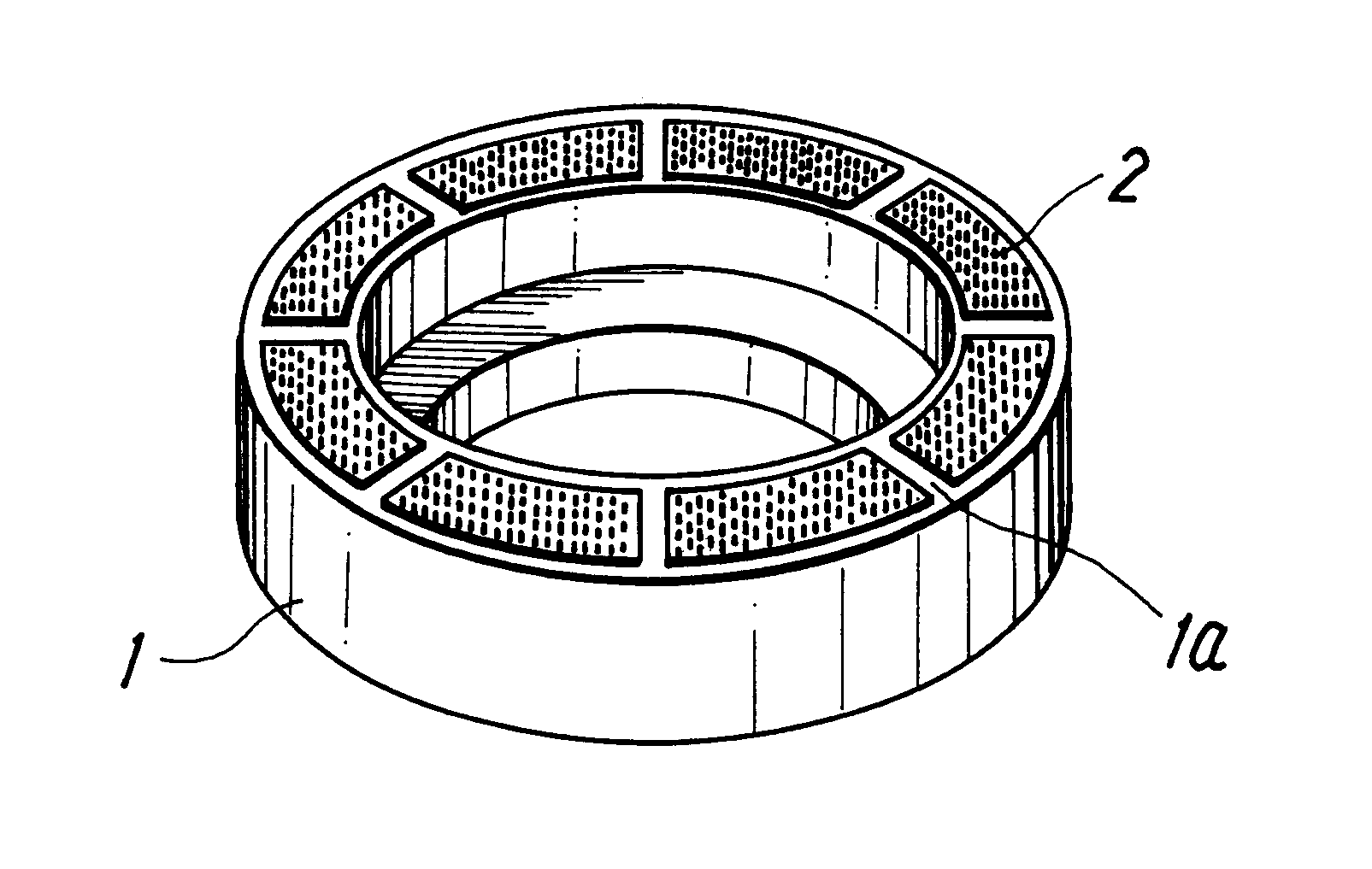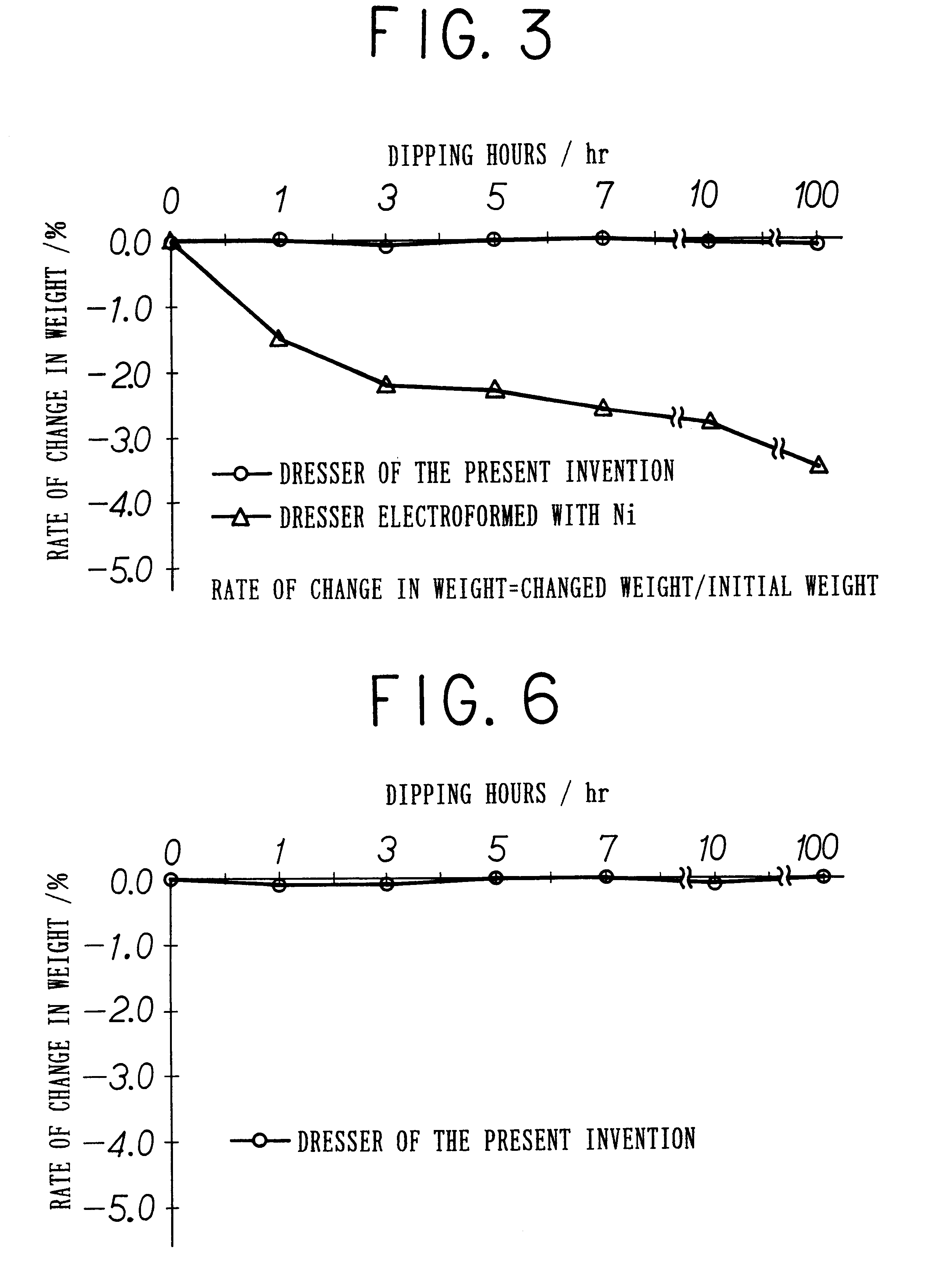Dresser for polishing cloth and manufacturing method therefor
a cloth dressing and manufacturing method technology, applied in the direction of gear-teeth manufacturing apparatus, lapping machines, abrasive surface conditioning devices, etc., can solve the problems of reducing the polishing rate, and affecting the polishing effect of the cloth
- Summary
- Abstract
- Description
- Claims
- Application Information
AI Technical Summary
Benefits of technology
Problems solved by technology
Method used
Image
Examples
example 1
Diamond grit having a grain size of #100 / #200 is mixed with titanium-silicon alloy powder at 1:1 by weight so as to yield a mixture of volume ratio of 1:3. Then, an obtained mixed powder is filled in a graphite frame, and then it is sintered at a sintering temperature of 1,200 degrees Celsius and under a pressure of 50 Mpa for an hour by hot-pressing. After an obtained sintered product is adhered on a pedestal (refer to FIG. 1) made from a stainless steel (SUS 316) with an epoxy adhesive, the dressing face of the product is planarized and dressing-processed by using a GC grinding wheel having a grain size of #240 so that the thickness of the product and the height of protrusion of the diamond grit from the matrix may be 2 millimeters and 50 micrometers respectively. This forms a dresser.
The following acid-resistance test and durability test of grit-peeling-off were carried out on the dresser.
In the acid-resistant test, a sliced sintered product is dipped in a nitric acid water solut...
example 2
Diamond grit, coated with titanium carbide of about 2 micrometers by a CVD method, having a grain size of #100 / #200 is mixed with titanium-silicon alloy powder at 1:1 by weight so as to make a mixture having a volume ratio of 1:3. Then, an obtained mixed powder is filled in a graphite frame, then it is sintered at a sintering temperature of 1,200 degrees Celsius and a pressure of 50 Mpa for an hour by hot-pressing. After an obtained sintered product is adhered to a pedestal made from stainless steel (SUS 316) with an epoxy adhesive, the dressing face of the product is planarized and dressing-processed by using a GC grinding wheel size of #240 so that the thickness of the product and the height of protrusion of the diamond grit from matrix may be 2 millimeters and 50 micrometers, respectively. This becomes a dresser. The following acid-resistance test is a durability test for grid-peeling-off carried out for the dresser under the same conditions as in Example 1.
first embodiment
The result of the acid-resistance test is shown in FIG. 6. The figure shows that no increase in weight of the product is seen and the product has superior acid-resistance. Furthermore, similarly as in the first embodiment, peeling-off of the diamond grit and change in the height of protrusion are observed at four points on the dresser before and after dressing. Neither peeling-off of the diamond grit nor change in the height of the protrusion of the diamond grit is observed before and after dressing. The product is therefor confirmed to exhibit superior durability in holding grit.
By using the dresser for a CMP polishing cloth, when used for CMP processing under strongly acidic conditions, the diamond grit will not peel off, and stable dressing is carried out. Furthermore, according to the manufacturing method in the present invention, the dresser for a CMP polishing cloth can be obtained by a simple method.
PUM
| Property | Measurement | Unit |
|---|---|---|
| thickness | aaaaa | aaaaa |
| thickness | aaaaa | aaaaa |
| weight | aaaaa | aaaaa |
Abstract
Description
Claims
Application Information
 Login to View More
Login to View More - R&D
- Intellectual Property
- Life Sciences
- Materials
- Tech Scout
- Unparalleled Data Quality
- Higher Quality Content
- 60% Fewer Hallucinations
Browse by: Latest US Patents, China's latest patents, Technical Efficacy Thesaurus, Application Domain, Technology Topic, Popular Technical Reports.
© 2025 PatSnap. All rights reserved.Legal|Privacy policy|Modern Slavery Act Transparency Statement|Sitemap|About US| Contact US: help@patsnap.com



